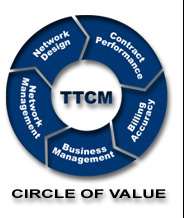




TTCM Savings Area:
Telecom Auditing
Published In: Volume
3 Issue 1
Date: May,
2004
|
Let's say you run an inbound call center, primarily using published toll-free numbers. Each call from a payphone incurs a Payphone Surcharge fee, which goes to the payphone owner to reimburse them for usage expenses on toll-free calls. Most companies accept the Payphone Surcharge, typically around $.24, as the cost of doing business. But what if the calls you are receiving aren't legitimately linked to your services? What if scammers have invented yet another way to generate revenue for themselves at your expense? How big of an impact could that have on your business and what can you do about it? Let's say an unscrupulous deli or liquor store owner put in a pay phone, preferably in a back room for "employee" use. If you live in Florida, you can even install a pay phone in your house! Now, let's have that person attach a simple autodialer that is programmed to call out to a large, rotating sequence of toll free numbers which can be obtained in minutes with a few simple internet searches. If an autodialer sent out calls on just 10 payphones, at a rate of four calls per minute, it could collect millions! The outbound call cost is zero to the scammer since they are dialing 800 numbers, but they receive the Payphone Surcharge revenue for each completed call. Sure it's illegal, but that obviously isn't stopping them. While each charge is small, the dollars can quickly add up. Reports of companies getting thousands of dollars in bogus monthly surcharges is not unusual. Over the period of a few years, the cost is huge. So, should this really be considered a legitimate cost of doing business?
Unfortunately, it's unlikely you'll find anyone to "hold the bag" for your excess costs going back over time. You get charged by your IXC and that charge eventually gets returned to the payphone owner through a series of financial transactions. Everyone will pass the buck back up the stream. And keep in mind that the scammers can cleverly distribute the pain over multiple numbers to keep the total claim by a single company small. But you can stop the problem going forward if you take the right steps, which involve determining the extent of the problem's impact on your business, the source of the problem, and the level of change to be made in your inbound telecom environment. A small investment now will pay for itself over and over in the years to come.
©2004,
TelAssess, Inc. All rights reserved. |
![]()
©2004, TelAssess 800.657.1595
Designed by Stylus
Designs
